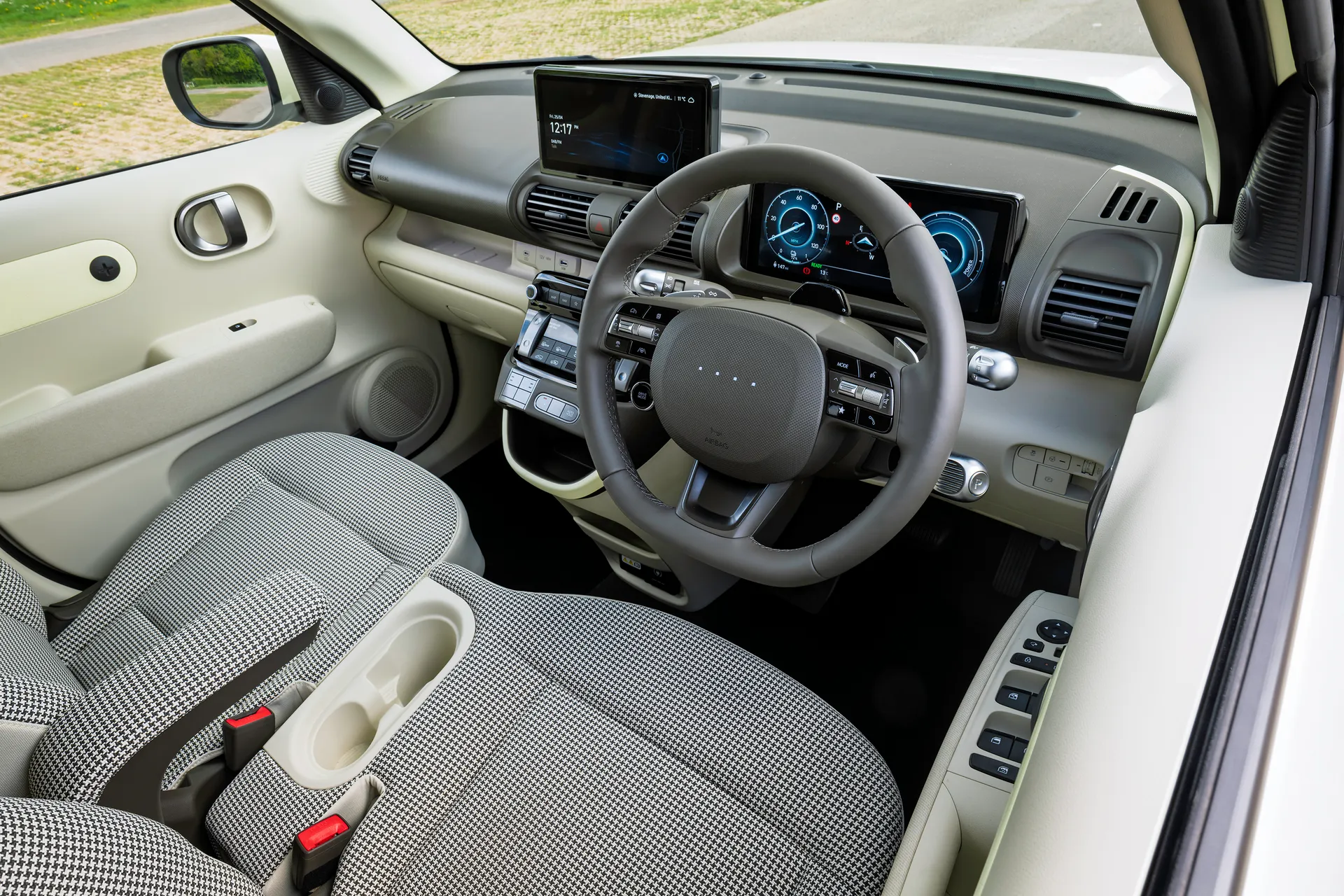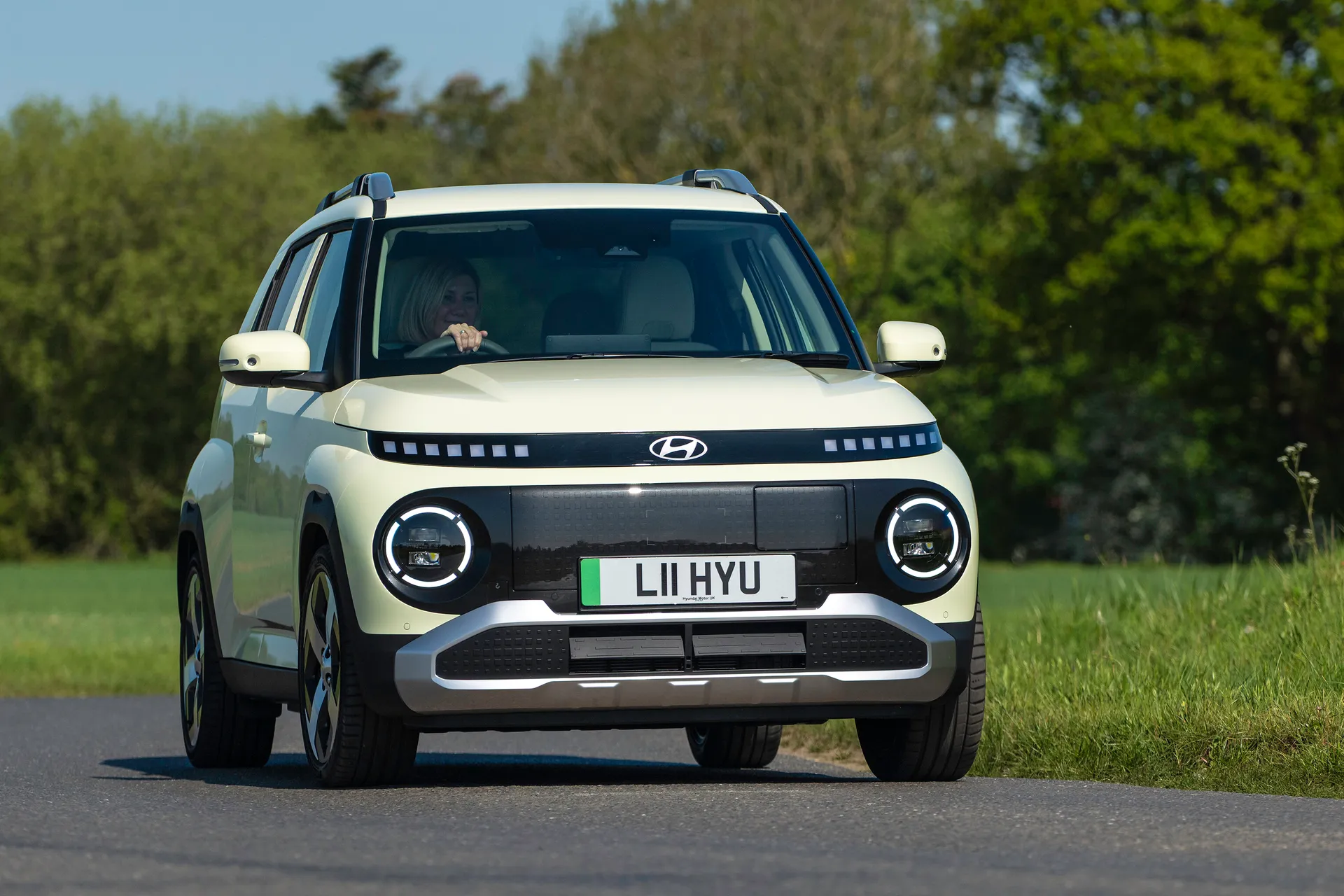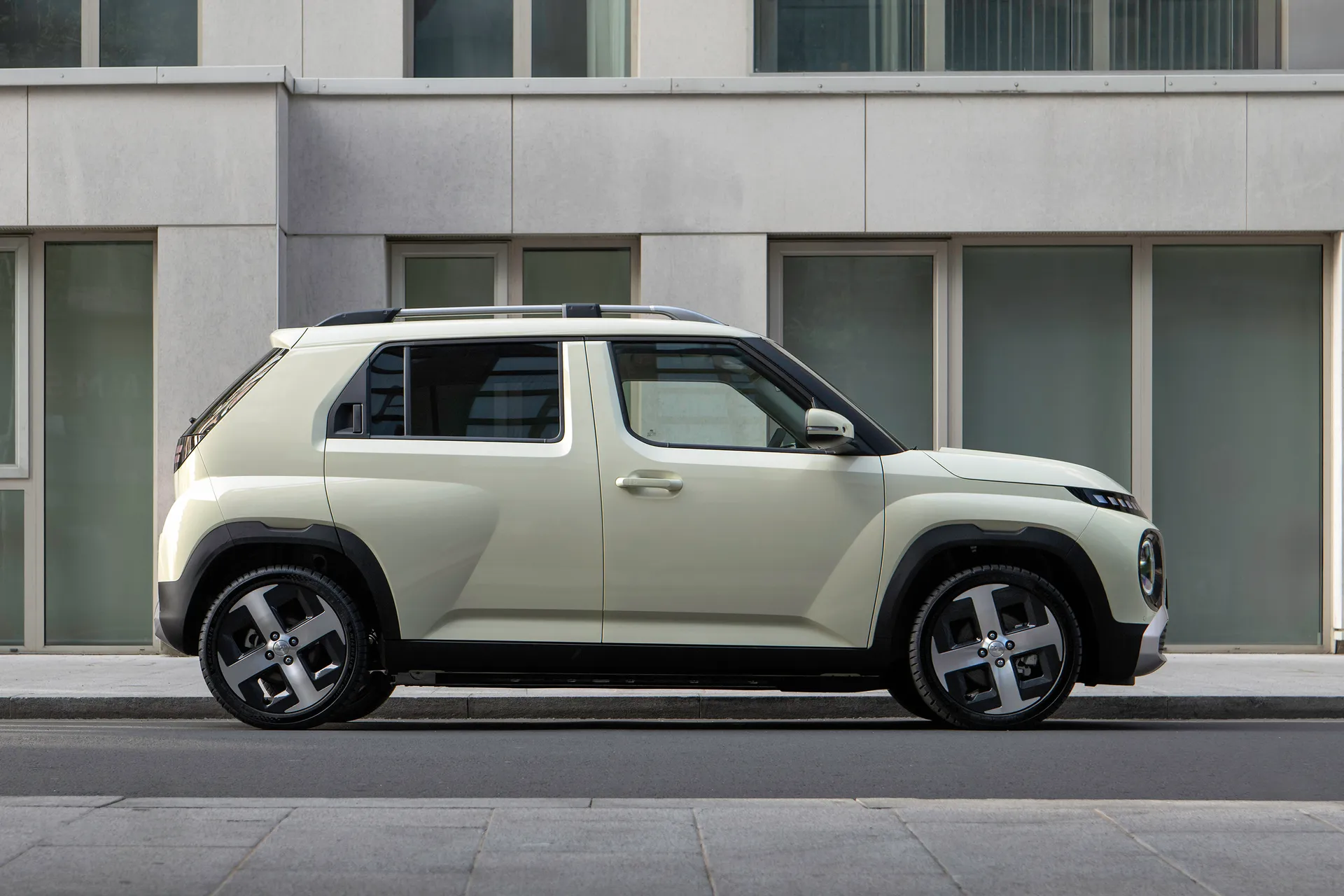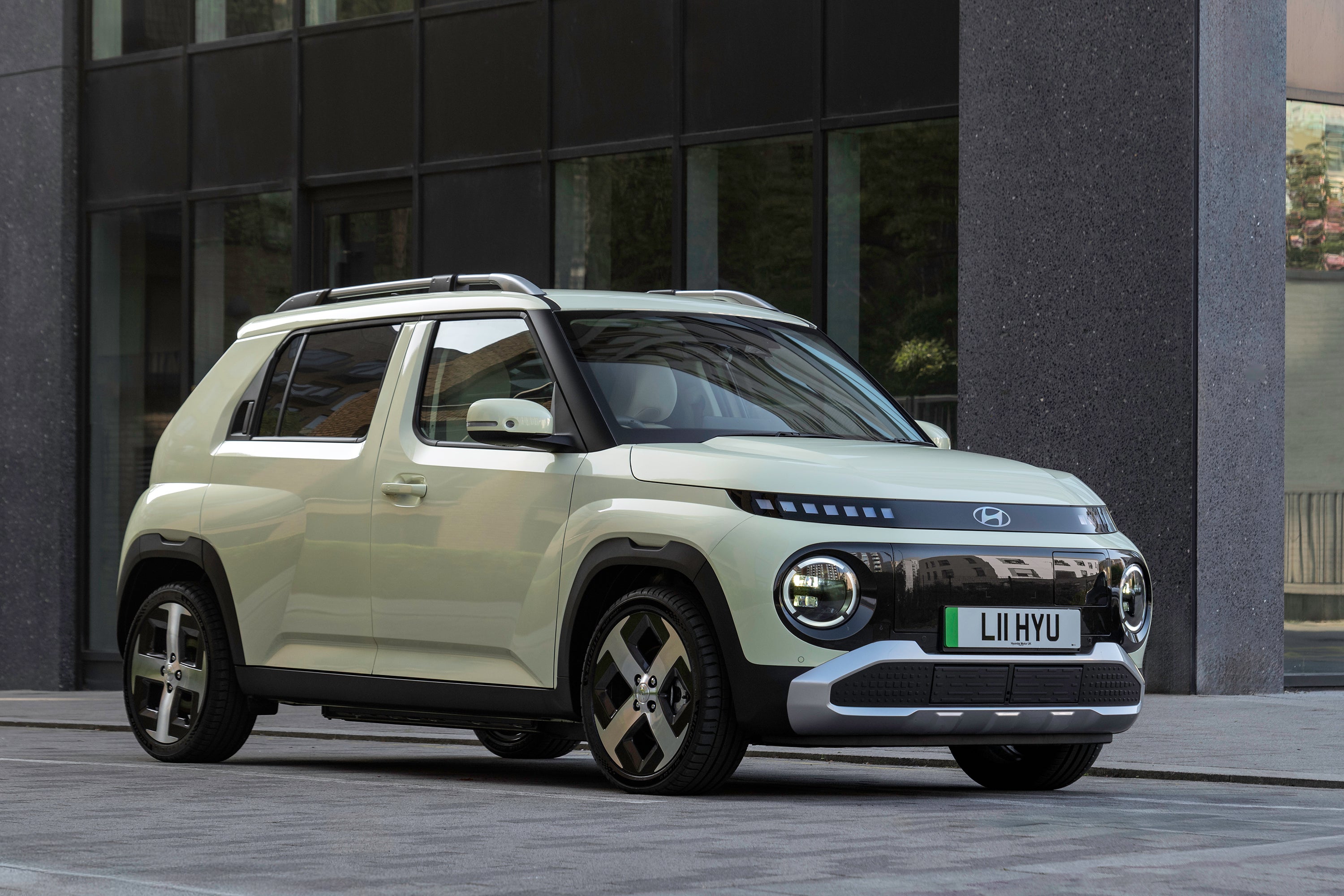Hyundai Inster Review 2025: Price, specs & boot space
Written by Richard Aucock
Quick overview
Pros
- Distinctive styling
- Flexible interior
- Lots of large car technology
Cons
- Only four seats
- Pricey compared to most of its rivals
- Range could be better
Verdict: Is the Hyundai Inster a good car?
"The Hyundai Inster is a charming electric car with a surprisingly spacious and high-quality interior. Despite its diminutive size, it has the sort of onboard tech more commonly seen on premium cars, although prices do reflect this."

The Hyundai Inster is a small electric car designed to stand out from the crowd. The South Korean firm’s smallest EV, it is a car for those who want a smaller, more affordable electric car, but don’t want to skimp on the luxuries found in larger cars.
The Hyundai Inster has the styling to help it stand apart from many other motors. It is a short, tall, boxy car that’s packed with modern design touches, from the combination of square and round LED lighting at the front, to an interior that’s packed with thoughtful features. It’s anything but ordinary.
If you like large car technology, the Hyundai Inster has you covered. The infotainment system is just as comprehensive as models such as the Hyundai Ioniq 5 which cost almost twice the price. You can even get an interior tech pack that includes a three-pin plug socket to charge devices.
The Hyundai Inster is available with a choice of two batteries, either 42kWh or 49kWh. The larger battery has a range of up to 229 miles. The Hyundai Inster Long Range has a bit more power too, which is useful.
To drive, the Hyundai Inster feels really good in town. It is very quiet, and the electric drivetrain gives it a sophisticated feel. It’s light and nimble, too. It does run out of puff a little at motorway speeds though, and wind noise is noticeable on a run, too.
While there’s lots of space in the rear of the Hyundai Inster, it is a strict four-seater, rather than being able to take five. The boot is a bit on the small side too, although a sliding rear seat does help here. And while the Hyundai Inster is packed with tech, prices do reflect this. On the other hand, it is a more sophisticated machine than other small car rivals – you pays your money…
Is the Hyundai Inster right for you?
The Hyundai Inster is a tempting choice for those seeking a more affordable electric car that’s also something a bit different to the norm. For many, the design will sell it. It’s genuinely different, with an abundance of stylish details, wrapped up in a distinctively boxy body.
Inside, the Hyundai Inster punches well above its size. It’s spacious and comfortable both front and rear, and occupants aren’t short-changed in terms of technology or safety features, either.
What could let the Hyundai Inster down is its combination of price and range. The basic car only has a 200-mile range, while even the Long Range version falls short of 230 miles on a full charge. Given prices that position it above similarly-compact small cars, this could be a deal-breaker for some.
However, for those who want one of the most modern, stylish and comfortable city-friendly EVs, the ultra-reliable, super-dependable Hyundai Inster is definitely worth a look.
What's the best Hyundai Inster model/battery to choose?
The Hyundai Inster range opens with the 42kWh Standard Range battery. This is combined only with ‘01’ trim, to create an entry-level version with a more affordable lead-in price. The standard level of equipment is good, but we'd avoid it simply because the 01 trim level does without the clever flexible seating.
With that in mind, you'll need to upgrade to the 02 trim, which is only available in Long Range form with the larger 49kWh battery pack for a slightly improved range figure.
The Hyundai Inster Cross is the range-topping version. It’s not cheap, starting from almost £29,000, but it delivers the most complete Hyundai Inster experience. We’d consider stretching the monthly electric car PCP payments and choosing this model if you can.
What other cars are similar to the Hyundai Inster?
The Hyundai Inster has one very well-known rival – the Dacia Spring, which hit the headlines at launch for being the UK’s cheapest electric car. The Spring now has a direct rival, the Leapmotor T03, which has a similarly boxy five-door city car style, and is also built in China. Both models undercut the Hyundai Inster by a significant margin.
The most expensive Hyundai Inster is nearly twice the price of the cheapest Dacia Spring, but buying the latter involves accepting significant compromises in terms of handling and build quality. The Leapmotor has its issues to contend with, as well.
The Hyundai Inster’s price also puts it into competition with the bigger Citroen e-C3 and Vauxhall Frontera Electric. Meanwhile, style-seekers after a head-turning electric car will also find the new Fiat Grande Panda to be a temptingly-priced alternative – again, it manages to undercut the Hyundai Inster.
Finally, the exciting Renault 5 is another compelling rival to the Hyundai Inster, particularly because of its standout style and ultra-desirable interior.
Comfort and design: Hyundai Inster interior
"The Hyundai Inster has a superb interior. It is spacious, welcoming and packed with thoughtful details. It also has some seriously impressive technology, helping it stand apart from more conventional rivals."

If you thought the Hyundai Inster was distinctive and charismatic on the outside, wait until you see the interior. Instead of the formulaic layouts some cheaper electric cars possess, the Hyundai Inster is bright, colourful and genuinely welcoming – it’s a great place to spend time.
For starters, the Hyundai Inster has a refreshing layout that combines high-end digital displays with tactile, premium-looking buttons and dials. If you recognise some of the tech from larger, much more expensive cars such as the Hyundai Ioniq 5 and Genesis GV60, you’d be right – this small car genuinely has big car gadgetry.
The Hyundai Inster has a steering wheel that is a pleasure to hold, too. It has proper physical buttons, which are tactile, and a prominent round drive mode button. Instead of a Hyundai logo, it has four illuminated pixels in the centre. These are interactive and change colour to highlight different states – blue for the car being switched on, red for reverse selected and green for charging.
The Hyundai Inster comes as standard with a black interior, which is fine. But we much prefer the black and beige alternative (a no-cost option), which helps underline its novel design. The colourscheme really suits the Hyundai Inster, particularly when combined with Buttercream Yellow or Bijarim Khaki matte exterior paint finishes.
Quality and finish
The Hyundai Inster is a car that’s not been built down to a price, and it shows. The sheer quality of the interior is noteworthy, with upmarket surfaces and soft-touch trims. Compared to cars such as the Dacia Spring, it’s in a different league – in fact, there’s no comparison in terms of quality and finish.
The Hyundai Inster is a premium car from the outside, too. The paint finish sparkles, panel gaps are even and the LED lighting looks very upmarket – both the ‘pixel’ squares front and rear, and the main LED driving lamps.
For an added-extra special touch, the Hyundai Inster is available with matte-finish paint. This sleek satin finish is available in Aero Silver, Bikarim Khaki, Dusk Blue or, on the Hyundai Inster Cross, Amazonas Green. It adds further to the upscale feel.
Infotainment: Touchscreen, USB, nav and stereo in the Hyundai Inster
The Hyundai Inster is well equipped on the infotainment front. All models come as standard with a 10-25-inch driver display and central 10.25-inch touchscreen with standard sat nav. Apple CarPlay and Android Auto smartphone integration are standard too.
The Hyundai Inster comes with a 10-year subscription to Hyundai’s Bluelink Lite service. This brings dedicated EV routing – it will automatically guide you to en route chargepoints during long journeys – and over-the-air updates. Bluelink Plus is a paid upgrade, with live and remote services – new Hyundai Inster buyers get six months for free.
The Hyundai Inster has a standard DAB stereo, with all models getting front and rear speakers. The Hyundai Inster 02 upgrades the audio slightly by adding front tweeters. A premium audio option is not available.
The Hyundai Inster has a front USB Type C port and front USB Type C charger. On Hyundai Inster 02 and Cross, there is a Type C charger in the rear too. The wireless smartphone charging pad is standard on the Hyundai Inster 02 and Cross.
Space and practicality: Hyundai Inster boot space
The Hyundai Inster is a spacious small car. The firm, comfortable front seats give an SUV-like view over the bonnet, and its tall body makes it easy to step in and out. The only way in which you really notice its diminutive nature is the closeness of the door armrest – and, of course, your fellow front seat passenger.
The Hyundai Inster has plenty of stowage spaces, including a shelf on the dashboard that’s illuminated by cool ambient lighting on ‘02’ models. There’s a roomy wireless charging pad in the centre console – while a unique detail we love are the cupholders built into the extra-wide driver’s seat. There’s a handy armrest as well.
Because the Hyundai Inster is a little narrower than regular small cars, it’s a four-seater only. There is no provision for a third passenger in the rear, and a third seatbelt is not fitted. For two people, however, it’s again surprisingly spacious, particularly the Hyundai Inster 02 with the standard sliding rear seat. In its rearmost position, all-round space is genuinely impressive, even for adults. The backrests also recline, a feature normally only found in much larger cars.
The Hyundai Inster 01, without the sliding rear seat, has less rear legroom, but it’s still an easy car for even taller people to get in and out of, aiding its practicality.
The standard Hyundai Inster 01 has a 280-litre boot. This is somewhat smaller than rivals such as the Citroen e-C3 – which is, of course, also a larger car on the outside, too. Even the smaller Dacia Spring has a larger boot than the Inster, though.
The Hyundai Inster 02 has a sliding rear seat. This allows the boot to expand from 238 litres to 351 litres, depending on how much rear passenger space you need. Both Hyundai Inster versions have a split-fold rear seat, which expands to 1059 litres.
The seats fold fully flat with the boot floor, and even the front seats fold flat. You could, then, fold the passenger seat to help load something like a surf board or a bicycle with a wheel removed, or fold both when parked up and sit in the back to create a lounge-like ambience.
Special mention to visibility within the Hyundai Inster. The big side windows give a superb view out, with the low sides helping you position it accurately in town. The high bonnet is again helpful here, while the cut-off rear (and standard parking camera) means reverse parking is a breeze.
Handling and ride quality: What is the Hyundai Inster like to drive?
"The Hyundai Inster is a simple and straightforward car to drive, making it ideal for city centre motoring. A few more shortcomings are apparent when you leave the city limits – but there are distinct strengths too, such as its comprehensive safety assist tech."

The Hyundai Inster is a city-sized car that is most at home in crowded suburbia. The high seating position and great visibility are complemented by light steering and nimble dynamics, making it an easy car to drive. It also has the safe, secure feeling of a small SUV behind the wheel – something enhanced further by the Hyundai Inster Cross version.
Because it is an electric car, the trademark silence is present and correct. Petrol-powered city cars can sometimes be buzzy and raucous, particularly when driven out of town, which makes the Hyundai Inster’s peaceful progress all the more noteworthy.
At speed, the Hyundai Inster feels impressively stable and reasonably well-planted for such a small car. The extra weight of the batteries, located low down in the chassis, undoubtedly helps here.
The ride is unsettled, however, with a near-constant jiggly feeling on all but the smoothest bits of tarmac. In the corners, meanwhile, the Inster rolls quite a bit, but it feels tidy enough for a car intended to spend much of its life at lower speeds in urban environments.
What motors and batteries are available in the Hyundai Inster?
The Hyundai Inster 01 features a 42kWh Standard Range battery combined with a 97PS electric motor. 0-62mph takes 11.7 seconds and it has an 87mph top speed.
The Hyundai Inster 02 and Inster Cross each come with a 49kWh battery combined with a 115PS electric motor. 0-62mph performance is better, taking 10.6 seconds, and it has a 93mph top speed. Both versions have the same 147Nm torque figure. It’s more than you normally get in petrol-powered city cars, giving the Hyundai Inster a feeling of having easy-going, more relaxed pulling power.
EVs are capable of delivering all of their torque figures instantly, but the Inster is much more measured off the line. Perhaps a little too much so – although the throttle becomes more eager in Sport mode, the Inster never feels like in a hurry to set off.
Once it finally does get a move on, though, the Inster Long Range arrives at 30mph quite briskly. Beyond that, progress feels as though it slows quite significantly, but given the Inster's urban brief, it doesn't seem like much of an issue.
Instead of a regular gearlever, the Hyundai Inster has a rotary stalk on the right of the steering column. Twist forward for drive, backwards for reverse, and press a button on the end for park. Tactile to use, it’s the same controller as on the Hyundai Ioniq 5.
Hyundai Inster range: How far can you travel on a charge?
The entry-level model with the 42kWh battery has a range of up to 203 miles on a full charge, while the more powerful long-range version with the 49kWh battery has a range of up to 229 miles.
During our UK drive of the car we averaged 3.8 miles per kWh without trying, and on a route made up mostly of national speed limit A and B-roads. That figure should be well above four miles per kWh if biased more towards the kind of urban driving the Inster is designed for.
Refinement and noise levels
As mentioned, the Hyundai Inster is very refined in town. Swapping out a buzzy petrol engine for a smooth, silent electric motor gives it grown up refinement that’s a match for bigger EVs.
The Hyundai Inster isn’t completely silent-running, though. The suspension can make a bit of noise when driving over bumps and rough road surfaces, particularly with the larger 17-inch alloy wheels of higher-grade models.
Also noticeable is the emergence of wind noise at motorway speeds. This is due to the boxy shape, but it does mean you have to crank up the stereo as speeds rise – and you’ll notice you have to raise your voice when speaking to passengers.
Safety equipment: How safe is the Hyundai Inster?
The Hyundai Inster has not yet been crash-tested by independent organisation Euro NCAP. It does, however, have plenty of safety technology as standard. This includes front, side and curtain airbags, a driver status monitor in-car camera, front collision avoidance assist and intelligent speed assist.
The Hyundai Inster also has high-tech Highway Drive Assist 1.5. This adaptive cruise control system helps maintain a set distance from the car in front, even if they slow down or speed up. The driver simply sets the speed limit and the car does the rest. It is further aided by lane keep assist, and intelligent speed limit assist.
The Hyundai Inster Cross also has an ingenious blind spot view monitor. When the driver indicates, a live camera feed of the blind spot flashes up in the driver display – in the right dial if you’re indicating right and vice versa. It’s a feature normally seen on premium Genesis models, and is extremely useful in spotting vehicles that might otherwise be hidden. The presence of this tech alone is reason enough to pay extra for a Hyundai Inster Cross.
Hyundai Inster charging times: How much does it cost to charge?
"The Hyundai Inster is an efficient car that helps make the most of its two battery choices. The fast-charge speed isn’t the best around, though, which slightly limits its long-distance practicality. Reliability should, however, be superb."

The Hyundai Inster Standard Range can cover up to 203 miles on a single charge. The Long Range pushes this up to 229 miles. The most efficient version, with 15-inch alloy wheels, covers 4.3 miles for every kWh of charge – and even the Hyundai Inster with 17-inch wheels have a strong 4.1-mile figure.
Real-world efficiency of the Hyundai Inster will be improved thanks to its standard heat pump. This is particularly beneficial in improving efficiency during cold and hot weather.
The Hyundai Inster is an electric car with clever onboard tech allowing you to schedule recharging when plugged in at home. This enables you to take advantage of cheap overnight tariffs, helping cut charging costs.
If you have a 7kW wall box, the Hyundai Inster Standard Range will take six hours and five minutes to charge. The Hyundai Inster Long Range takes six hours 44 minutes.
The Hyundai Inster will take 55 minutes to charge from 10-80% at a 50kW public charger. If you find a more powerful rapid charger, the 73kW peak rate of the Standard Range takes it from 10-80% in 30 minutes. The larger Long Range has a higher 85kW peak, meaning it takes the same 30 minutes.
Hyundai Inster reliability and warranty
The Hyundai Inster is likely to be a very reliable small electric car indeed. Hyundai is a world leader in terms of EV tech, meaning the technology is both simple and well proven. Using technology from bigger, more premium cars in the range also bodes well.
The Hyundai Inster has the firm’s generous five-year, unlimited-mileage warranty. There’s also an eight-year, 100,000-mile warranty for the battery.
Hyundai Inster insurance groups and costs
The Hyundai Inster may not be quite as cheap to insure as some of its lower-priced rivals. The Hyundai Inster should be cheap to run though, thanks to the efficiency of its electric drivetrain. Its reliability is likely to prove a boon, too.
VED car tax: What is the annual road tax on a Hyundai Inster?
The Hyundai Inster currently enjoys free road tax. This changes from April 2025, but the first year rate will only go up to £10. More frustrating is the fact electric cars will now be required to pay the same flat rate charged on petrol and diesel cars – meaning the annual road tax on a Hyundai Inster will be £195.
For company car drivers, the Hyundai Inster boasts the ultra-low Benefit-in-Kind tax rates enjoyed by all electric cars. It will be attractive to fleet drivers thanks to its generous levels of standard equipment.
Hyundai Inster price
"The Hyundai Inster isn’t the cheapest small electric car on the market. However, it has technology some of its rivals can only dream of, making this a genuine small car that thinks big."

The Hyundai Inster does not feature a headline-grabbing price as part of its appeal. While a Fiat Grande costs from around £21000, the Hyundai Inster range opens at a notably more expensive £23,505. Adding the long-range battery increases this to £25,055.
The Hyundai Inster you really want – the Long Range 02 version – starts from £26,755, while the Hyundai Inster Cross costs from £28,755. These are punchy prices that are more on a par with the Renault 5 Electric, and that’s a car available with a larger battery and longer range.
Trim levels and standard equipment
The Hyundai Inster is available in three simple trim levels, called 01, 02 and Cross.
The Hyundai Inster 01 features 15-inch alloy wheels, climate control, electric folding door mirrors, rear parking sensors and camera, keyless entry with stop-start button, 10.25-inch touchscreen with sat nav plus steering wheel remote control buttons.
The Hyundai Inster 02 adds larger 17-inch alloy wheels, roof rails, full project LED headlights and LED rear lights, heated front seats, sliding and reclining rear seats, rear privacy glass, heated steering wheel, front and rear parking sensors, extra stereo speakers and wireless smartphone charging.
The Hyundai Inster Cross is broadly the same as the 02. It adds the ‘cross’ exterior design pack, which comprises chunky front and rear bumpers, side skirts and a different design of alloy wheel. Also included are an electric sliding glass sunroof, rear parking guidance system, blind spot collision avoidance and the clever blind spot view monitor. Reverse parking collision avoidance is standard too.
Ask the heycar experts: common questions
Is the Hyundai Inster a good car?
What is the range of the Hyundai Inster?
What size is the Hyundai Inster?
Get our latest advice, news and offers
Keep me updated by email with the latest advice, news and offers from heycar.
By submitting you agree to our privacy policy



